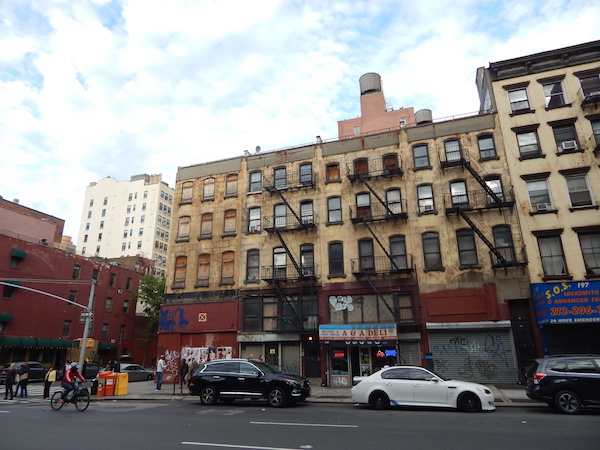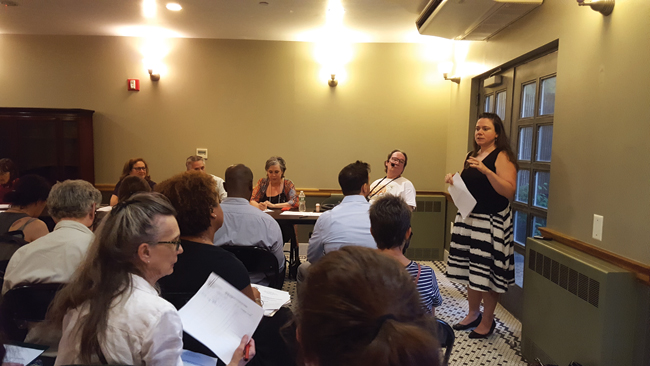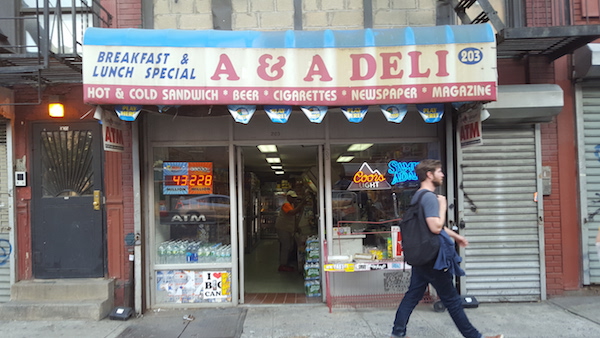
BY DUSICA SUE MALESEVIC | The city says it is taking steps toward finally rehabilitating four dilapidated buildings it owns and that have languished for years — eyesores that have been a source of consternation for neighbors and a community focused on affordable housing.
The buildings — 201, 203, 205 and 207 Seventh Ave. (on and near the corner of W. 22nd St.) — have a “long tortured history,” Joe Restuccia, co-chair of the Housing, Health & Human Services Committee, said at the start of the Community Board 4 (CB4) meeting on Thurs., May 18. “We’re at the beginning of a new process again.”
Restuccia said the city has owned the buildings since 1978. Over the decades, the four buildings shifted from one program to another, he said, while the programs themselves also changed.
Around five years ago, the city had “designated” a developer for the renovation, but “that developer did not work out and so now we are at another new chapter of this process,” he said.
Restuccia noted it hasn’t been a lack trying on the part of the city agency that manages the programs, the Department of Housing Preservation and Development (HPD). “Pretty much since the 2012 period, the goal has always been to do a renovation [and] tenant ownership,” Restuccia said.
“I’d like to just say upfront we acknowledge that this has taken too long. We acknowledge that it’s an eyesore for the community — no doubt about it,” said Jordan Press, executive director for development and planning for HPD’s government affairs unit. Press said HPD is eager to work with the community and the tenants, “who will become cooperative owners of the building in the future.”
The buildings are now part of a city program called the Affordable Neighborhood Cooperative Program (ANCP), which aims to create affordable co-ops. The ANCP was created in 2012 to rehabilitate buildings via Tenant Interim Lease (TIL) — a program in which tenants renting in city-owned buildings are helped to form co-ops, and manage and maintain their buildings. Eventually, the tenants buy their apartments for $250.
The four buildings are separate but contiguous, and have 14 units with four commercial spaces on the ground floor, said Christine Retzlaff O’Connell, director of ANCP’s property disposition and finance. There will be a gut renovation and the four buildings will be joined into one, she said. An elevator will be installed, and the preliminary plan has the building going up two floors to seven stories, increasing the number of units to 18, she said. HPD intends to preserve the facade of the buildings, which Restuccia said were built in 1870.
O’Connell declined to say who the new developer was, only noting it was a nonprofit organization. “We are in the process of formalizing the relationship and sharing that with the residents of the project so we tonight are not going to disclose,” she said.
Restuccia tried twice to get the information but to no avail. “The community expects to understand what’s happening here” after all these years, he said.
O’Connell said that the increase in units meant that the project will be required to go through ULURP (Uniform Land Use Review Procedure).

Restuccia said CB4 has an affordable housing plan that had identified the four buildings as a site to be developed. When the board looked at the zoning, there was the feeling that at least 22 units could be built, he said. “I’m kind of surprised you’re talking about a ULURP, we actually recommended… a mayoral zoning override to short-circuit this process,” he said.
The override would cut down on the timeline HPD proposed, which has construction slated to begin in November 2018. The override is an administrative action as opposed to a full-fledged series of public hearings, he said.
Restuccia stressed the board does not take it lightly. “We want to maximize our public sites for affordable housing and I think everyone in the community is on the same wavelength,” he said.
O’Connell said there were five families “associated” with the buildings, with three families residing there and two relocated (Restuccia said it was two families living there). After the renovation, which will require all tenants to vacate during construction, tenants can buy in at $2,500, O’Connell said. All the families will have the opportunity to come back, she said, whether they want to be a co-op shareholder or renter.
“At this point, we’re determining affordability once we better understand what it costs to renovate the project,” she said, referring to the other vacant units. “We typically set sale prices affordable to families earning 120 percent AMI.” AMI, or area median income, is about $80,000 for an individual or $100,000 or so for a family of four, Press said.
The buildings are at a prime location in Chelsea. If put on the market, the assemblage could sell from $9 to $14 million, according to two real estate brokers who appraised the property at Chelsea Now’s request.
Joe Rosales, director of investments sales and advisory services for Keller Williams Tribeca, said in an email there was only 22,204 buildable feet, and estimated the value to be in the $13 to $14 million range in today’s market. Jeremy Curtin, with BOND New York Properties, LLC, estimated $9 million for the assemblage. If the buildings were renovated and upgraded, he estimated a one-bedroom could rent for $3,500 per month.
There is currently one commercial tenant at the building: A & A Deli. “There’s a store there, a deli that’s been in the community a long, long, long time,” said Bill Borock, who attended May 18 meeting in his capacity as president of Council of Chelsea Block Associations. “We’ve been fighting for mom and pop stores. We hope you’ll be able to arrange… a long-term lease at a reasonable rate.”
O’Connell said all commercial tenants are currently on a month-to-month lease, and the city does not provide assistance for them. “Typically when a commercial tenant vacates for the construction period, which can be 18 to 22 months, sometimes the commercial tenant finds a new place and they might not want to come back,” she said. “There might be a scenario here where that’s not the case.”

Michael Walsh, of the 100 West 20th Street Block Association, asked if the commercial space would become market rate after renovation. Restuccia said yes, and as W. 22nd St. and Seventh Ave. is not off the beaten path, it may be filled by a business that can pay high rent.
The owner of A & A Deli declined to comment.
Kumaran Vijayakumar, who has lived on W. 22nd St. for about 15 years, said he had attended two or three meetings over the last 10 years about the buildings. “The biggest thing is just, for me like everyone I think, is just the timeframe,” he said. “This all sounds great but makes me think that by 2018 we’re be talking to a different group and another program.”
“It is very frustrating for our community to know that this has just been this total outlier. Many other city buildings have moved ahead,” said Restuccia.
HPD did not respond to Chelsea Now’s questions sent after the meeting.
Sally Greenspan is a board member of preservation group Save Chelsea, and told Chelsea Now before the meeting it was a “disgrace” that the buildings were the state they were in. “We call it a rat hotel,” she said. “It should be a source of pride for the neighborhood, not a boarded blight.” Greenspan credited City Councilmember Corey Johnson for “tirelessly working” on this issue.
After the meeting, she said she was happy HPD came with a plan, but “We’re so aggravated about this; we’re so frustrated. There’s more loose ends than I would like there to be.”
Restuccia concurred, telling HPD toward the end of the meeting that the committee was happy they came. “I want caution you not to disappear for six months and come back and say it’s all already to go. That’s not going to be helpful,” he said. “I think it’s important the next time you come back you have full information and also we need to know where the tenants are in this thing.”
He added, “It’s not all black and white here, but we do know one thing: The status quo is not tolerable.”



























